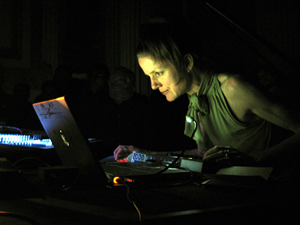interview with Kaffe Matthews
http://annetteworks.com/events/images2007/INTERVIEW_Digicult07.htm
INTERVIEW WITH KAFFE MATTHEWS AND LUCA FOR MARCH ISSUE
DIGICULT MAGAZINE.
[OV translated to Italian, found at http://www.digicult.it/digimag/index.asp ]
1) The relation between sound and furniture can involve many other ‘objects’, do you think you will explore new sound opportunities in this field?
Yes absolutely, with the intention of making new music as well as new objects to experience it from.
This is the whole intention of the collaborative project music for bodies, http://www.musicforbodies.net that I launched last year.
In fact I had imagined that we would have made some sonic foot stools, sofa and launderette sonic waiting bench by now for example, with a sonic fashion show in production for the spring, but the Sonic Bed building around the world is pretty time consuming.
I am also coming to understand how much such a new way of making and experiencing music, ie. in and for a Sonic Bed for example, changes and opens up ways of composing, so this new object making process will be more drawn out than I had anticipated. Of course, music for bodies is always on the look out for interested and active potential collaborators, so, hallo! do get in touch if you are out there…
2) Could you describe bio-resonance?
Bio resonance is a healing practice that, simply put, assesses the frequencies at which your cells and therefore organs are vibrating. You could think of it as a Western or technological version of acupuncture. Again, simply put, with Bio Resonance healing, if you are well, your body will be vibrating/resonating/singing in harmony, and if you are sick, the vibrations will be non-harmonic. A bio resonance practitioner attempts to assess the organs and frequencies that are out of balance in your body, and put back the frequencies you need to make your body sing ‘in tune’.
However, it’s a pretty subjective practice from the point of view of the practitioner in that their own interpretation of the situation, how you feel, what they need to look for in the first instance, feed directly into the process. It is by no means a straightforward or hard and fast technique of reading and sending frequencies from and into the body via some special connector, and so open to much doubt. However, the field of vibrational medicine is a new fascinating and fast growing one, and I’m clear that it “works”.
– How can it be used in sound making?
Firstly, these cellular human body vibrations occur at frequencies within the audible range for humans, although at tiny and therefore imperceptible volumes. With the aid of amplifiers and accurate ways of reading these frequencies as they are emitted, it seems that we have some fascinating sound sources.
Secondly, working with a B-R practitioner could produce sonic maps of the body that could be used as scores for music for bodies making. This is the aspect we are near to working with.
>>> And how can music evolve in physical experience?
If you mean, how can a music change through experiencing it physically? well i think that is part of the minefield of questions around human perception, and i don’t really have room to discuss that here…
But you only have to see the queues of old women and kids waiting for a ride in Sonic Bed or a Sonic Armchair to “listen” to what they might otherwise call noise and certainly not music, to realise that experiencing music as physical sensation that moves and spins around you as you sit or lie, that has a direct and intimate contact with your body , really is a way in to the enjoyment of music.
This kind of music making itself then makes other requirements on the composer, so there will be and there is, as I am now discovering, quite an evolution in compositional strategies.
3) Being bigger than Armchair the Sonic Bed could also be a meeting place for people. What do you think about music and social places?
Going to a gig or concert can be and still is not only a fun but a vital and sometimes the only way of enjoying music especially if it is live. The PA, size of space and interaction with everyone else’s experience of the event, be it joyous or painful all add.
Making a Sonic Bed creates a potentially social space which not only addresses these issues but also offers a very intimate experience which could even be with a stranger. Will people get into Bed with someone they had never met before, AND in a public space? In Europe and now Canada, I have found that this poses no question, folk hop in and out happily if there is room, but in China and Taiwan, the responses were quite different, which often tuned out to be related to not wanting to take shoes off in public.
Altogether it can be a little like jamming in on the underground though, its rare that Sonic Bed visitors will talk to each other!
4) How much is important technology for your artistic production?
Technology is currently an unquestionalby vital tool and instrument in the making of my work and has been for at least 15 years.
5) On the web site of your project is possible to find a discussion room. Is visitorÕs feedback important for the developing of your work?
Yes.
Its important to be out of the artist and producer ghetto lands of studio and performance.
yes, audience/visitor input is a process that slows down the making initially , takes up time to talk!, but it also contributes a vital feed. This collaborative approach is one of the main concerns behind mfb’s .
eg. The 6 month installation at Rich Mix, London, where passers by could just drop in and join in or hear or witness what we were making at the time certainly exemplified this ,
